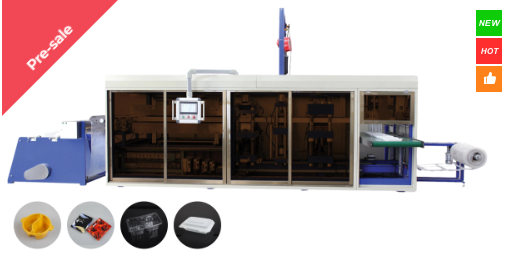Views: 0 Author: Site Editor Publish Time: 2025-09-22 Origin: Site
Are all thermoforming methods the same? Twin Sheet Thermoforming creates hollow, double-walled parts. Single-sheet uses one layer for simpler designs. In this article, we explore key differences. You will learn when to choose each method.
Twin Sheet Thermoforming involves heating two plastic sheets simultaneously. Each sheet is molded over a separate form. They are then fused to create a hollow, double-walled part. Unlike single-sheet thermoforming, it allows complex geometries and internal structures.
Key Steps:
Heat two sheets to forming temperature.
Mold each sheet separately.
Combine sheets through fusion or sealing.
Trim excess material for final part.
Twin sheet parts are ideal for hollow or reinforced components that require strength and design flexibility.
Various plastics work well for twin-sheet applications:
ABS – impact-resistant, rigid.
HDPE – chemical-resistant, durable.
TPO – temperature-resistant, flexible.
PETG – clear, aesthetically versatile.
The material choice affects strength, weight, and surface finish. It also determines which industries the parts are suitable for.
Match material properties to the application to improve durability and reduce waste.
Twin sheet parts offer superior structural integrity. The double-wall design increases rigidity without adding extra weight. Hollow sections allow internal reinforcements, insulation, or embedded components.
Benefits include:
Enhanced load-bearing capacity.
Hollow designs for airflow or insulation.
Integration of metal or carbon fiber supports.
Hollow twin-sheet parts often outperform thicker single-sheet parts in strength-to-weight ratio.
Twin-sheet thermoforming enables multi-color parts. It allows custom shapes and detailed surfaces. Designers can produce eye-catching products that meet branding requirements.
Features:
Two-color combinations.
Smooth finishes with precise tool contact.
Complex geometries with integrated ribs.
Use two-color sheets to reduce secondary painting or coating steps.

Single-sheet thermoforming uses one heated sheet molded over a single form. Air or vacuum pulls the sheet onto the mold. Plugs or pins control wall thickness in critical areas.
Applications: trays, panels, covers, and simple containers.
Common materials: ABS, HDPE, PS. The single-wall construction limits hollow sections and reduces structural flexibility. Thicker sheets may be needed for strength, increasing material costs.
Single-sheet parts are suitable for lightweight, low-load applications.
Single-sheet thermoforming is generally simpler and faster. Tooling costs are lower, and setup time is minimal. However, it cannot create hollow or reinforced parts without secondary assembly.
Choose single-sheet thermoforming for high-volume, low-complexity production.
| Feature | Twin Sheet | Single Sheet |
|---|---|---|
| Wall Structure | Double-walled, hollow | Single-walled, solid |
| Strength | High, reinforced | Moderate |
| Design Flexibility | Complex geometries, integrated components | Limited to mold shape |
| Production Cost | Higher tooling and setup | Lower tooling cost |
| Cycle Time | Longer due to two sheets | Faster for simple parts |
| Applications | Heavy-duty pallets, automotive, aerospace | Trays, covers, light packaging |
Twin-sheet parts resist bending and impact better than single-sheet equivalents. Hollow interiors allow reinforcement without weight increase. Use twin-sheet parts for heavy-duty and load-bearing applications.
Twin-sheet requires precise alignment and dual molds. Setup is more complex. Single-sheet is faster for simple, flat parts. Production speed should be balanced with part functionality.
Twin-sheet enables parting line variation, internal ribs, and two-color effects. Single-sheet is limited to single-wall shapes. Consider twin-sheet for aesthetic or functional complexity.
Twin-sheet has higher upfront costs but delivers better long-term ROI in heavy-duty applications. Single-sheet is cheaper but may need thicker materials or secondary assembly. Calculate ROI considering durability, material savings, and production efficiency.
Twin-sheet pallets support higher loads and resist deflection. Single-sheet is suitable for lighter loads under 1,500 lbs. Evaluate cargo weight before choosing thermoforming type.
Twin-sheet allows hollow, multi-color containers. Single-sheet fits simple packaging needs.
Twin-sheet parts handle vibration, impact, and insulation needs better. Single-sheet is rarely used for critical structural parts.
Single-sheet avoids hollow areas, reducing microbial growth. Twin-sheet can be adapted if internal surfaces are sealed. Always consider sanitation and compliance for food or medical applications.
Twin-sheet parts outperform in load tests and impact resistance. Single-sheet may require thicker walls to match strength.
Hollow twin-sheet parts save material while maintaining strength. Single-sheet often uses more material for similar performance. Material savings improve sustainability and reduce shipping costs.
Twin-sheet allows smooth, uniform surfaces due to complete mold contact. Single-sheet can have uneven thickness or stretching marks. Use twin-sheet for premium-looking consumer products.
Consider part size, weight, and application environment. Twin-sheet is better for heavier, delicate, or load-bearing items.
Factor in tooling, material, and labor costs. Single-sheet suits low-cost, high-volume production.
Twin-sheet reduces material usage and improves recyclability when designed efficiently. Single-sheet can be simpler to recycle.
Check compatibility with conveyors, forklifts, and automated lines. Twin-sheet may require larger molds and precise handling.Test prototypes before full-scale production to avoid costly mistakes.
Emerging plastics and composites offer better impact resistance and thermal stability.
Robotics and automated mold handling can shorten twin-sheet cycle times.
Twin-sheet enables new product types: hollow automotive panels, insulated pallets, and multi-color packaging. Staying updated with material science and automation improves competitiveness.
MINGDU offers Twin Sheet Thermoforming machines with superior strength and design flexibility. They improve material efficiency and support complex designs. Single-sheet is faster and cheaper for simple parts. Choosing the right process ensures maximum value, durability, and performance.
A: Twin Sheet Thermoforming is a process that fuses two plastic sheets to create hollow, double-walled parts.
A: Twin Sheet Thermoforming offers superior strength, hollow designs, and more design flexibility compared to single-sheet methods.
A: It provides better structural integrity, allows multi-color designs, and improves material efficiency.